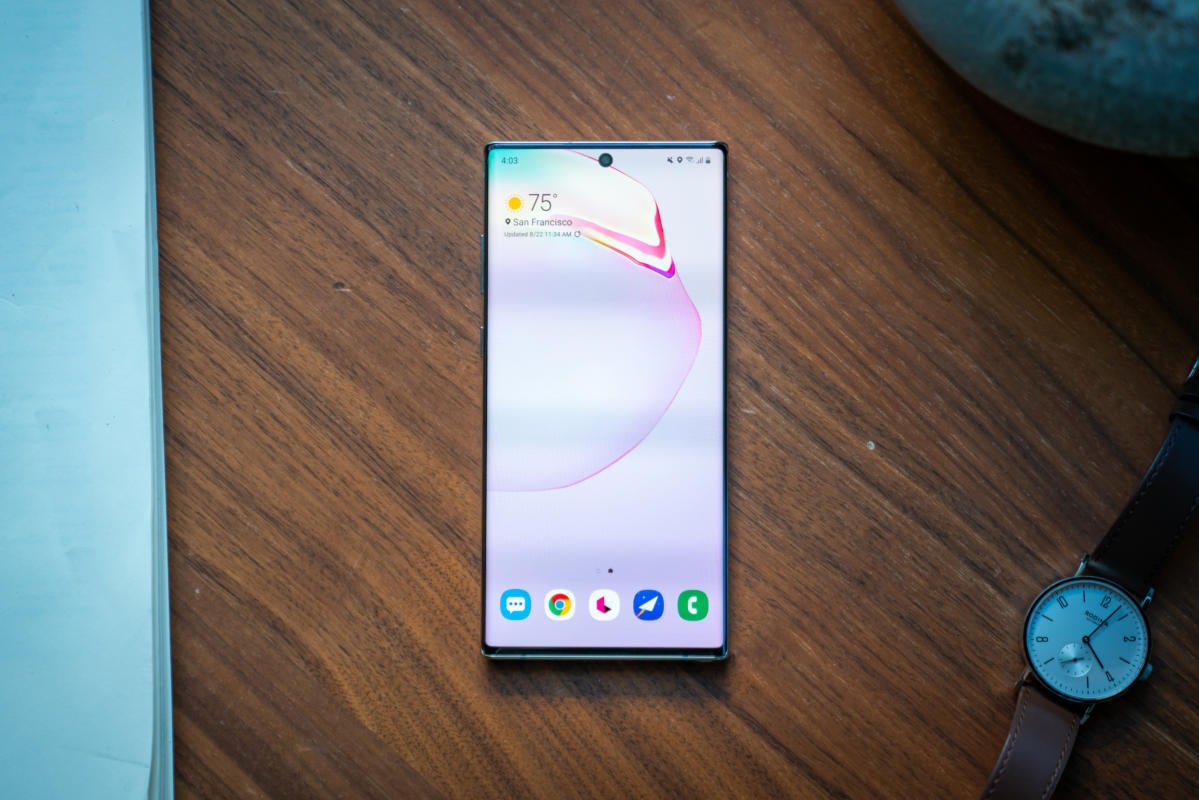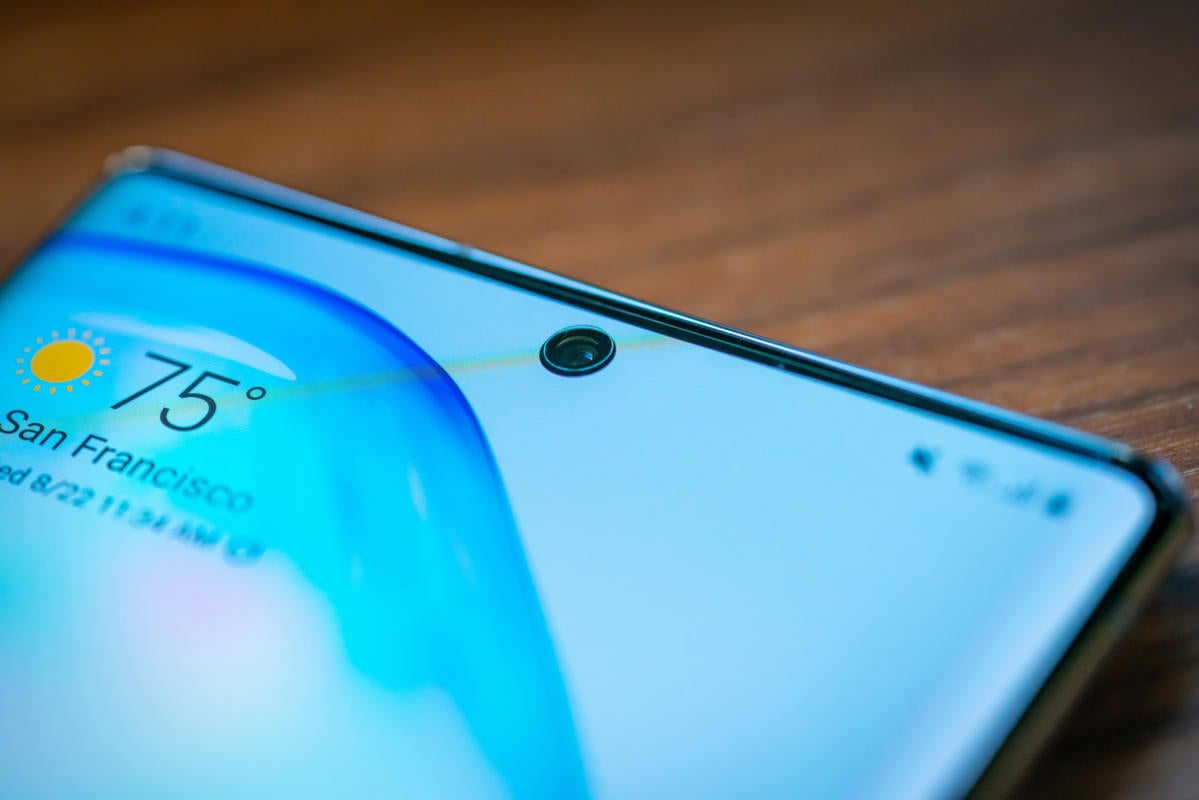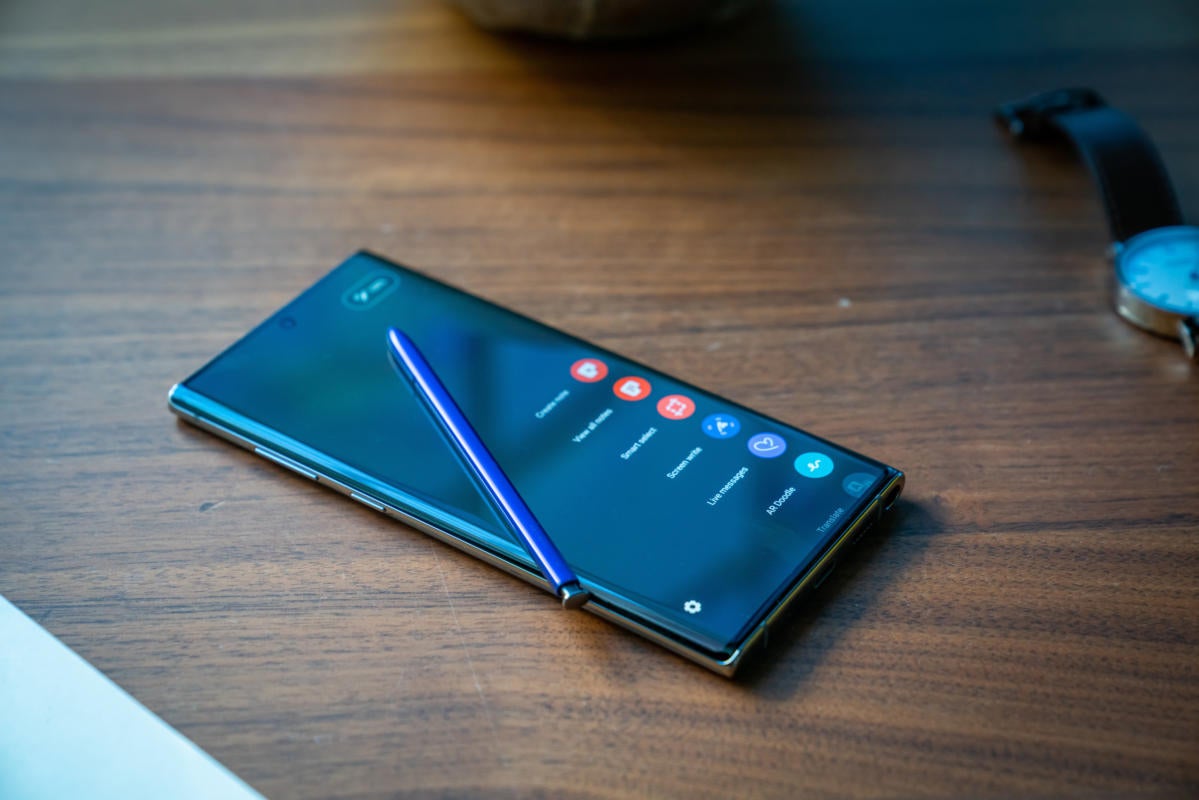 Credit: Daniel Masaoka/IDG
Credit: Daniel Masaoka/IDG
The Galaxy Note 10+ will be too expensive for some people. It’ll be too big for others. Some will balk at its lack of a headphone jack and a few might really want a dual selfie cam. For those people, there’s the Galaxy S10+, which is an excellent alternative that checks off all of the above boxes without sacrificing too much of what the Note 10+ brings.
 Daniel Masaoka/IDG
Daniel Masaoka/IDG
That’s a lot of screen.
But if the four drawbacks I list above aren’t an issue, the Galaxy Note 10+ should quickly become your favorite phone of all time. No matter what handset you’re upgrading from, the Note 10+ will be an improvement, likely a significant one. It’s not just the speed (though it’s basically the fastest phone ever made) or the display (which is pretty much flawless). From the bezels to the battery life, the Note 10+ is at the very top of its game, capping off Samsung’s strongest year in recent memory.
It’s so good, I’m not sure where Samsung goes from here. While previous Galaxy Note phones have left clear upgrade paths for future models, the Note 10+ clips every branch with a package that’s as stunning as it is expensive. As long as you can handle its massive size.
The closest yet to an small-screen design
The first thing you’ll notice about the Note+ is what it doesn’t have. Namely, bezels. Samsung has somehow trimmed the area above and below the display beyond even what the Galaxy S phones brought earlier this year, giving the Note 10+ a real full-screen feel. They bezels are so skinny, I didn’t even mind the extra millimeter of space on the bottom.
 Daniel Masaoka/IDG
Daniel Masaoka/IDG
The “hole-punch” selfie cam is much less offensive on the Note 10+ than it is on the S10+.
Without the Note 9’s bezel, which held the front camera, receiver/speaker, and various sensors, Samsung has gotten creative with the 10+. Like the S10, there’s a hole in the screen for the camera, but the centered circle is way easier on the eyes than the S10’s right-corner design. It’s still too low to center itself in the status bar, but most of the time, I barely noticed the camera on the Note 10+ (even without applying special gradient wallpaper).
The back of the Note 10+ repositions the camera array in the left corner—a first for the Note line—and introduces a new Aura Glow color that turns the back of your phone into a mirror prism. It’s a cool look when the light hits it just right, but it’ll pick up more fingerprints than a glass door in an elementary school after a Popsicle party.
Along with the camera, the left side of the phone is also where you’ll find the devices’s two lone buttons: the volume rocker and the power button. That gives the Note 10 the distinction of being one of the few smartphones that doesn’t have the power button on the right side, which will take some getting used to. Taking screenshots and turning off the screen will take some re-training of your muscle memory, but it’s a design decision most people should be OK with, especially since it means the elimination of the dedicated Bixby button. With its limited button array, Samsung offers a few options when you hold down the power button, which is what it should have done all along.
 Daniel Masaoka/IDG
Daniel Masaoka/IDG
The Note 10+’s Aura Glow color is simply stunning in the right light.
The other thing that you won’t find in the Note 10+ will be much more missed: the headphone jack. Samsung says it was eliminated to make the phone thinner, but I’m not sure the trade-off was worth it. Samsung’s phones were among the few holdouts that clung to the legacy jack, and if the only benefit is barely perceptible thinness, I don't see the point. That said, the bundled AKG USB-C headphones are as good as the 3.5mm version.
A giant screen pushes the limits
With little else to distract your gaze on the front of the phone, the screen gets all of the attention, and it’s absolutely up to the task. In no uncertain terms, the Note 10+’s 3,040 x 1440 display is the best I’ve ever laid eyes on, with impressive brightness, remarkable color accuracy, and impeccable uniformity. The only thing it’s missing is a higher refresh rate like the One Plus 7 Pro, but even at the standard 60Hz, its still impressive.
One massive improvement over the S10+ is the fingerprint sensor. It’s still an ultrasonic sensor, unlike the optical sensor in the One Plus 7 Pro and Galaxy A50, but it’s loads more reliable here. The constant rescans that I had to do on the S10 weren’t an issue on the Note 10+, and I was able to unlock the phone as mindlessly as I did with a physical scanner. For this we can thank the placement of the sensor, which is a good deal higher than it is on the S10 and in a more natural spot. But Samsung has also given the sensor a serious speed boost, so you no longer have to hold your finger on it for more than a split-second. After several generations of Galaxy flagship phone fingerprint sensors that were less than good, the Note 10+ finally nails it.
 Daniel Masaoka/IDG
Daniel Masaoka/IDG
The Note 10+ (center) isn’t just bigger than the Galaxy S10+ (left) and the Note 9 (right), it also was way more screen to contend with.
The Note 10+’s size presents some issues though. Don’t get me wrong, the Note 10+ isn’t alone in its immensity. In fact, several phones can challenge it for dominance:
- Note 10+: 162.3 x 77.2 x 7.9mm
- OnePlus 7 Pro: 162.6 x 75.9 x 8.8mm
- Galaxy S10+ 5G: 162.6 x 77.1 x 7.9mm
- Note 9: 161.9 x 76.4 x 8.8mm
- iPhone XS Max: 157.5 x 77.4 x 7.7mm
A tremendous screen-to-body ratio makes the Note 10+ feel much larger than its contemporaries. As is the case with recent Notes, it’s taller and boxier than the S10, which amplifies the hugeness of the screen. I experienced far more accidental touches than with the S10+, especially when attempting to use it with one hand. But even with two hands, it’s a tricky phone to hold, and I cycled through several grips before I found one was both comfortable and usable.
 Daniel Masaoka/IDG
Daniel Masaoka/IDG
You’ll need really long fingers to even attempt to use the Note 10+ with one hand.
The shape might have worked with previous Notes, but on the 10+, the form very much dictates your grip, making it somewhat less comfortable to use than other big-screened handsets. As someone who loves giant phones, I think I’ve finally met my limit of what my hands can handle.
Impressive speed, storage, and battery life
The Note 10+ uses the same Snapdragon 855 processor as the Galaxy S10, which is to say it’s basically the fastest phone you can buy. The newer 855+ processor might beat it in some tests, but the 12GB of RAM and super-speedy and spacious 256GB of UFS 3.0 storage puts the Note 10+ ahead of its 855 peers. Apps launched incredibly fast and didn’t need to reload nearly as often, and the recent apps screen was populated with nearly 50 screens. And the vapor chamber cooling system that seemed like a gimmick on paper actually did keep the phone noticeably cooler than other 855 handsets.
 Daniel Masaoka/IDG
Daniel Masaoka/IDG
The Note 10+ is pretty much the whole package—but you’ll have to pay for it.
Even before Android 10 arrives, One UI on the Note 10+ is one of the most pleasurable Android skins I’ve used, rivaling even the Pixel phones for out-of-the-box smoothness. Controls are smart, gestures are intuitive, and it feels like an elegant, modern operating system built for the hardware that runs it. If you’re upgrading from a Note 5 or a Galaxy S7 that’s still on Touchwiz, the difference will be visually striking and probably a bit jarring (particularly if you turn on the ultra-black Night Mode, but you wont need to use it for very long to see just how much of an upgrade it is.
The Note 10+ has a 4,300mAh battery, a touch smaller than the 4,500mAh battery in the S10 5G, but still impressively large. The size translates into fantastic battery life that will easily get you through a full day. I never had to plug in my Note 10+ during my two weeks of testing, even after long days of work and streaming. Benchmarks echoed my real-world experiences with better than 11 hours of screen-on time, and if you flip on Adaptive power saving in the Device carrier settings, you’ll easily be able to push it to 12 hours. Short of a major battery breakthrough, the Note 10+ is as good as it gets.
More S Pen gimmicks lead the way
Samsung has once again added some new tricks to the Note 10’s signature feature, the S Pen, but the implementation is just as half-baked as last year. Samsung built Bluetooth into its mini stylus with the launch of the Note 9 so it doubled as a remote, but it never built out functionality beyond rudimentary camera controls and music playback.
 Daniel Masaoka/IDG
Daniel Masaoka/IDG
Along with the usual Air Commands, the S Pen on the Note 10+ also has gesture capabilities.
On the Note 10, the stylus can act as a sort of magic wand, so Instead of simply clicking to advance a track, you can wave your hand to change the camera mode or raise the volume from a distance. Does it work? For the most part, yes, though some of the gestures are tricky. Is it useful? Not really. Since the S Pen is generally docked inside the Note, it takes more planning to use Air Actions than the other S Pen features. I suppose there could be a situation where you prop up your S Pen to take a group photo and use the S Pen as a shutter, but it’s certainly not a feature you’re going to use every day.
 IDG
IDG
The Note 10+ will convert and index your messy handwriting into legible text so you can search for written words within notes.
Far more useful is the optical character recognition built into Samsung Notes. As always, the prime benefit of the S Pen is for quickly jotting down notes, but Samsung has made them way more useful in the Note 10+. After you save a note, you’ll have the option to convert your writing into text using a new button at the bottom of the screen. Even after a live demo, I was skeptical, but the OCR engine was remarkably accurate at turning my admittedly terrible handwriting into the right words. And if you leave your notes as scribbles, they’ll still be categorized as text and fully searchable, which is pretty great.
Extra cameras yield similar results
After the Note 8 brought a dual camera and the Note 9 debuted Dual Aperture, its somewhat surprising that the Note 10+ has a recycled camera array. Granted, it’s a four-camera array and one of the best one Samsung has ever made, but it would have been nice to see something new:
- Camera 1: 16MP Ultra Wide, f/2.2
- Camera 2: 12MP Wide, f/1.5-f/2.4
- Camera 3: 12MP Telephoto, f/2.1
- Camera 4: DepthVision
The fourth camera is the same time-of-flight lens Samsung introduced on the Galaxy S10+ 5G, and it’s responsible for sharper live focus images and videos as well as AR applications. The bundled Measure app works as well, but so do the ones on the Pixel and iPhone, without a 3D camera. The S Pen-powered AR Doodle is way more unique and fun, using the camera to track drawings you make on faces, but I don’t know how often people will use it. There’s also a 3D scanner built in that I had no luck with, but with patience, people have been able to generate usable images.
 Michael Simon/IDG
Michael Simon/IDG
If you zoom on on these portraits, you’ll see that the Note 10+ (left) did a better job with the edges and the bokeh, but it’s extremely similar to the S10+ (center) and note 9 (right).
The 3D camera will mostly be used for portraits, and it’s there where the S10+ excels. Live focus images (Samsung’s name for portraits) were excellent, with crisp edges and recognition of the tiniest details, but the differences between the Note 10+ and the S10+ or even the Note 9 are marginal. You’ll need to zoom in on the image above to see the fine details that the Note 10+ picked up.
 Michael Simon/IDG
Michael Simon/IDG
Like other Galaxy phones, the Note 10+ tended to oversaturate in bright light, but there’s no denying the beauty of its shots.
As far as the other three cameras go, you’ll certainly take great pics with the Note 10+, but they’re no better or worse than the other Galaxy phones Samsung sells. In fact, Samsung uses the same S10+ designation for the camera model (SM-G975U1), making it even more difficult to tell the pictures apart. Colors still lean a bit toward over-saturated in most lights, but most people won’t mind.
 Michael Simon/IDG
Michael Simon/IDG
While both of these Night mode photos are soft, the Note 10+ (left) also grabbed too much of the red from the flowers and added a tint to the rest of the photo, while the Pixel 3 XL (right) had a more accurate color balance.
New to the Note 10+ is the Night mode that arrived late to the S10, and it definitely helps with low-light shooting. Like Google’s method, you need to hold your phone steady while it processes the available light, but the results aren’t quite as spectacular. Night photos looked less realistic on the Note 10+, and the processing engine tended to get confused by the dominant color and had trouble focusing, where Google’s Pixel Visual Core handled the scene much better. But it’s definitely a step in the right direction.
Should you buy a Galaxy Note 10+?
There probably isn’t anything I wrote in this review that’s going to sway you to buy or not buy a Galaxy Note 10+. With an $1,100 price tag and top-of-the-line everything, it’s geared toward the Android user who wants the best, and boy, does it deliver.
 Daniel Masaoka/IDG
Daniel Masaoka/IDG
We’ll miss you, headphone jack.
And really, there’s no reason to wait. The Note 11+ (assuming there is one) will have a better camera and maybe a few display and design tweaks, but there isn’t too much Samsung can do to make it all that much better than the Note 10+. Until folding phones become a viable product or in-display cameras arrive, the Note 10+ is pretty much the epitome of Samsung’s smartphone evolution.
In a world of the Pixel 3a, Galaxy A50, and iPhone XR, there’s no real reason to pay $1,100 for a phone. But if you must, you won’t feel an ounce of buyer’s remorse with the Note 10+.

















